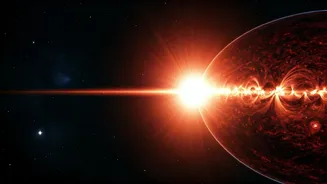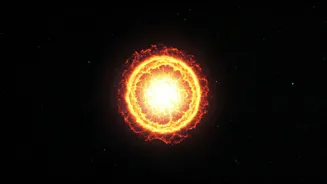Stellar Eruptions Explained
Stars, much like our Sun, aren't always calm. They periodically experience intense eruptions, including powerful flares and coronal mass ejections (CMEs).
These events involve the sudden release of vast amounts of energy and plasma, potentially reaching and impacting planets in their orbit. The driving force behind these eruptions is the star's magnetic field. This field, generated by the movement of electrically charged gas within the star, can become twisted and tangled, storing immense energy. When this stored energy is released, it triggers flares and CMEs. Flares are short-lived bursts of intense radiation, while CMEs are massive expulsions of plasma and magnetic field from the star's corona. The frequency and intensity of these events vary from star to star, with some stars being far more active and prone to eruptions than others. These stellar eruptions are a form of space weather, capable of significantly affecting any planets within their reach. For exoplanets, this space weather poses a serious threat, as energetic particles and radiation from these events can directly interact with their atmospheres.
The Threat to Atmospheres
When a stellar eruption occurs, the resulting blast of energy and particles can have a devastating effect on an exoplanet's atmosphere. Energetic particles bombard the atmospheric gases, potentially stripping them away over time. This process, known as atmospheric erosion, is particularly dangerous for planets with weak magnetic fields or those located close to their star. A planet's magnetic field acts as a shield, deflecting harmful particles and protecting the atmosphere. However, even strong magnetic fields might not always provide complete protection against the most powerful CMEs. The intensity of stellar eruptions, and their frequency, is a crucial factor. Frequent and intense eruptions can inflict more severe damage, potentially eroding the atmosphere faster than it can be replenished. For some exoplanets, the impact could be severe, leading to the loss of atmospheric gases like oxygen and water vapor, rendering the planet uninhabitable. The consequences of atmospheric erosion can vary widely, depending on the star, the planet's characteristics, and the intensity of the eruption. Understanding this complex interplay is crucial in determining the potential for life on exoplanets.
Magnetic Fields Matter
The presence and strength of a planet's magnetic field are key to its habitability in the face of stellar eruptions. Magnetic fields act as a protective barrier, deflecting charged particles from the star and preventing them from reaching the atmosphere. Without a magnetic field, the atmosphere is more vulnerable to erosion from the constant bombardment of stellar winds and the occasional CME. The strength of a planet's magnetic field is determined by factors like its internal structure, rotation rate, and the presence of a liquid, electrically conductive core. Planets with strong magnetic fields, like Earth, are better equipped to withstand the onslaught of space weather. The orientation of the magnetic field also plays a role, as a well-aligned field can deflect charged particles more effectively. However, even with a strong magnetic field, a planet's atmosphere can still be affected by extreme stellar events. A sufficiently powerful CME can overwhelm the magnetic field, allowing energetic particles to penetrate and damage the atmosphere. The magnetic field's effectiveness is closely tied to its interaction with the stellar wind and the planet's atmospheric density. Assessing the magnetic properties of exoplanets is a major challenge for scientists, but it is a critical step in assessing their potential for habitability.
Evidence of Eruptions
Scientists have gathered evidence of stellar eruptions and their potential effects on exoplanets using various observational techniques. Telescopes, both on Earth and in space, play a crucial role in detecting flares and CMEs from distant stars. By studying the light emitted by stars, astronomers can identify sudden bursts of energy that signal a flare. Observing the changes in a star's spectrum, which is the distribution of light across different wavelengths, also provides insights into these events. Additionally, scientists look for evidence of CMEs by observing the movement of plasma around the star. Furthermore, by studying the atmospheres of exoplanets, researchers can infer the effects of stellar eruptions. Analyzing the composition of the atmospheres can reveal signs of erosion, such as a decrease in the concentration of certain gases or the presence of unusual elements. It's difficult to directly observe CMEs impacting exoplanets, but scientists use models and simulations to estimate the extent of the damage. These studies require sophisticated instruments and careful analysis, but they're essential for assessing the habitability of exoplanets and understanding the influence of stellar activity on planetary environments.
Radio Burst Detection
Recent discoveries have provided valuable data to understand the behavior of stellar eruptions. Scientists have captured evidence of stellar coronal mass ejections by detecting powerful radio bursts emitted from distant stars. These radio bursts are believed to be caused by the interaction of CMEs with the surrounding stellar environment. Observing these bursts allows researchers to study the dynamics of plasma during these powerful eruptions. The analysis of these radio bursts can offer clues about the size, speed, and energy of the CMEs. The study of stellar radio bursts provides additional data about the star's overall activity level and provides a window into the magnetic field configuration. By analyzing these signals, scientists can gain a deeper understanding of the mechanisms behind stellar eruptions and their potential impact on nearby planets. These discoveries contribute to the ongoing effort to understand stellar space weather and its influence on the habitability of exoplanets. As technology advances, the capacity to observe these events improves, leading to a greater understanding of the cosmic processes that could potentially erase alien atmospheres.












